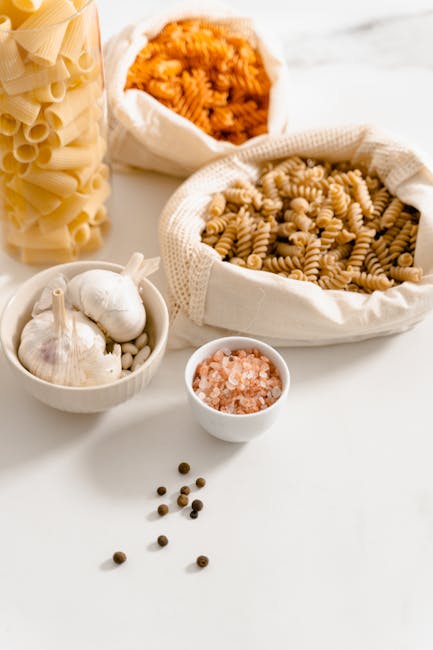25 Essential Tips for Gluten-Free and Allergy-Friendly Spiralizer Cooking
Welcome to the world of gluten-free and allergy-friendly spiralizer cooking! Whether you have celiac disease, gluten intolerance, or food allergies, spiralizing offers a fun and creative way to enjoy delicious and nutritious meals without sacrificing taste or variety. In this comprehensive guide, we will explore 25 essential tips to help you master the art of spiralizer cooking while adhering to a gluten-free and allergy-friendly diet.
1. Choose the Right Spiralizer:
Invest in a high-quality spiralizer that is easy to use and clean. Look for models that offer different blade options for creating a variety of noodle shapes and sizes.
2. Use Fresh Produce:
Opt for fresh fruits and vegetables to spiralize, as they will yield the best results in terms of taste and texture. Avoid using produce that is overly ripe or soft.
3. Wash Produce Thoroughly:
Prior to spiralizing, make sure to wash your produce thoroughly to remove any dirt, pesticides, or contaminants that may be present on the skin.
4. Peel Tough Skins:
For certain fruits and vegetables with tough or bitter skins, such as butternut squash or zucchini, consider peeling them before spiralizing to improve the overall texture of the noodles.
5. Experiment with Different Vegetables:
Don’t limit yourself to just zucchini and carrots! Try spiralizing a variety of vegetables, such as sweet potatoes, beets, cucumbers, and even broccoli stems, to add more color and nutrients to your dishes.
6. Pat Dry Spiralized Vegetables:
After spiralizing, use a clean kitchen towel or paper towels to gently pat dry the vegetable noodles. This will help remove excess moisture and prevent your dishes from becoming soggy.
7. Season Generously:
Enhance the flavor of your spiralized dishes by seasoning them generously with herbs, spices, and condiments. Experiment with different flavor profiles to keep your meals exciting and delicious.
8. Pair with Protein:
To create a well-rounded and satisfying meal, be sure to pair your spiralized vegetables with a good source of protein, such as grilled chicken, tofu, shrimp, or beans.

9. Incorporate Healthy Fats:
Add a dose of healthy fats to your spiralized dishes by drizzling them with olive oil, avocado, nuts, or seeds. Not only will this enhance the flavor, but it will also help your body absorb fat-soluble vitamins.
10. Avoid Cross-Contamination:
If you have food allergies or sensitivities, it is essential to avoid cross-contamination when preparing and cooking your spiralized meals. Use separate cutting boards, utensils, and cookware for gluten-free and allergen-friendly ingredients.
11. Read Labels Carefully:
When using packaged ingredients, such as sauces, seasonings, or condiments, always read the labels carefully to ensure they are gluten-free and free of any allergens that you need to avoid.
12. Make Your Own Sauces:
To avoid hidden gluten and allergens, consider making your own sauces and dressings from scratch using simple, whole ingredients. This way, you can customize the flavors to suit your preferences and dietary needs.
13. Stock Up on Gluten-Free Grains:
For a more substantial meal, consider serving your spiralized vegetables over gluten-free grains like quinoa, rice, or buckwheat. These grains will add texture and heartiness to your dishes.
14. Freeze Excess Spiralized Vegetables:
If you spiralize more vegetables than you can consume in one sitting, freeze the excess noodles in airtight containers or bags for later use. This will save you time and ensure you always have spiralized veggies on hand.
15. Get Creative with Garnishes:
Elevate the presentation of your spiralized dishes with creative garnishes, such as fresh herbs, citrus zest, seeds, or edible flowers. Not only will this add visual appeal, but it will also enhance the flavors of your meals.
16. Plan Ahead:
Take the guesswork out of meal planning by prepping your vegetables in advance. Spiralize a batch of veggies at the beginning of the week and store them in the refrigerator for quick and easy meals throughout the week.

17. Stay Informed:
Stay updated on the latest gluten-free and allergy-friendly cooking tips, recipes, and product recommendations by following reputable blogs, websites, and social media accounts dedicated to these topics.
18. Join a Support Group:
Connect with others who share similar dietary restrictions by joining a gluten-free or allergy-friendly cooking group. This can provide a sense of community, as well as a valuable resource for sharing tips and recipes.
19. Experiment with Different Cooking Methods:
Don’t limit yourself to just eating spiralized vegetables raw. Experiment with different cooking methods, such as sautéing, steaming, roasting, or stir-frying, to add variety and depth of flavor to your dishes.
20. Embrace Leftovers:
Don’t let leftover spiralized vegetables go to waste! Incorporate them into omelets, salads, soups, or stir-fries for a quick and easy meal the next day.
21. Educate Your Family and Friends:
If you have dietary restrictions, take the time to educate your family and friends about your needs and preferences. This will help them understand how to support you when cooking or dining together.
22. Treat Yourself Occasionally:
While it’s important to stick to your gluten-free and allergy-friendly diet, don’t forget to treat yourself occasionally to indulgent dishes or desserts that meet your dietary requirements. Balance is key to maintaining a healthy relationship with food.
23. Invest in Good Storage Containers:
Properly store your spiralized vegetables in airtight containers to maintain their freshness and prevent them from wilting or spoiling. Glass containers are a great choice for storing and reheating your meals.
24. Practice Mindful Eating:
Slow down and savor each bite of your spiralized dish, paying attention to the flavors, textures, and aromas. Mindful eating can help you appreciate your food more and prevent overeating.
25. Have Fun and Be Creative:
Above all, have fun with your gluten-free and allergy-friendly spiralizer cooking! Get creative in the kitchen, experiment with new ingredients and flavor combinations, and enjoy the process of creating delicious, healthy meals that nourish your body and soul.


